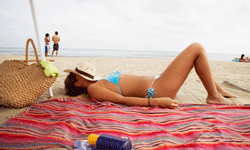Do sunny days and warm weather lure you outside to sunbathe, hoping to add a little color to your skin? Every year, the "California girl" standard of beauty sends millions of sun-worshippers to the pool, the beach or the tanning bed in search of the perfect tan.
Unfortunately, a bronze glow that's appealing today can turn into future problems, so it makes sense to learn more about the long-term effects of sun exposure before you head outdoors.
Advertisement
Tanning is the skin's natural way of protecting itself from the sun, but the truth is, there's no such thing as a healthy tan. All ultraviolet rays in sunlight are harmful to the skin, and the amount of damage depends on how long you stay in the sun.
A long afternoon on the beach or a three-set tennis match can result in red, sunburned skin that leads to blistering and peeling. It may also lead to heatstroke, a condition that occurs when the temperature regulating mechanism of your body is unable to keep up with the heat, causing dizziness, breathing problems, nausea, headaches or fainting.
Over the long haul, accumulated sun exposure causes wrinkles, sunspots, a leathery feel and premature aging. The most serious risk from excessive sun exposure is skin cancer. More than 1 million cases of non-melanoma skin cancer and 60,000 cases of melanoma skin cancer were diagnosed in 2008, according to the American Cancer Society [source: WebMD].
Today, while medical science warns that no amount of tanning is safe, some people are reluctant to give up their pursuit of a golden tan. Many misconceptions exist that there is a "safe" way to tan. Here's the real story behind the top five myths.
